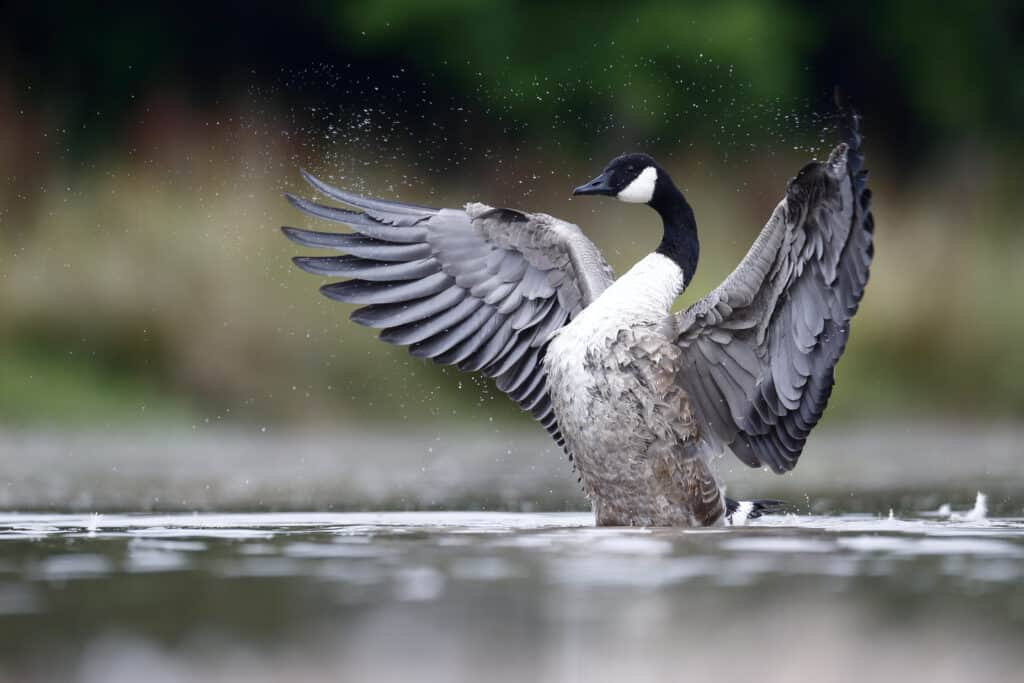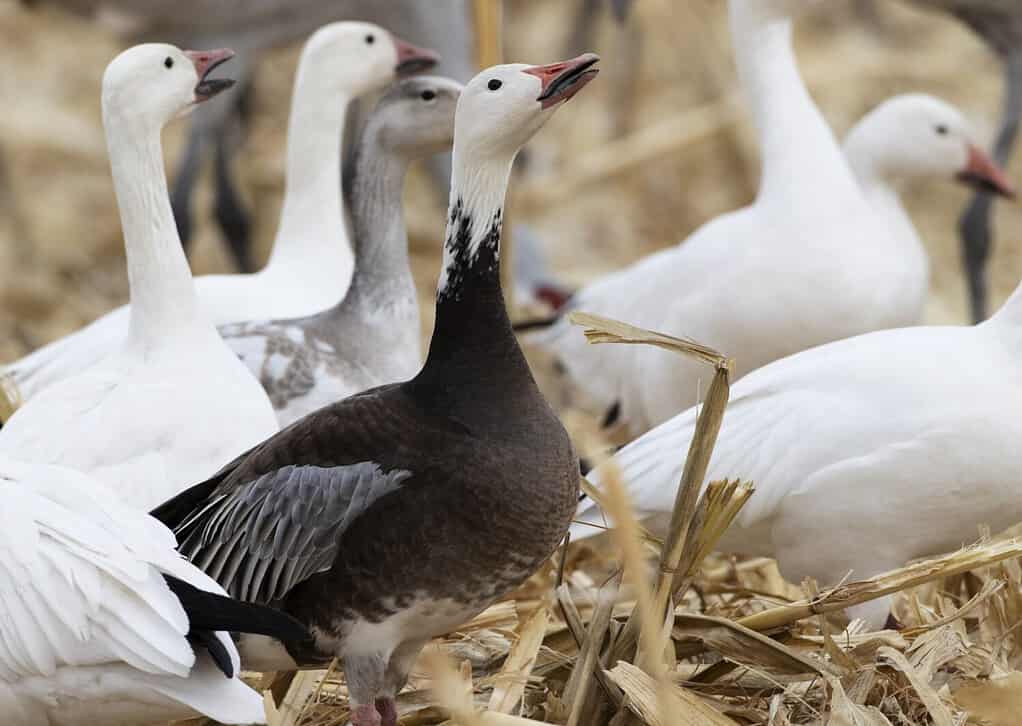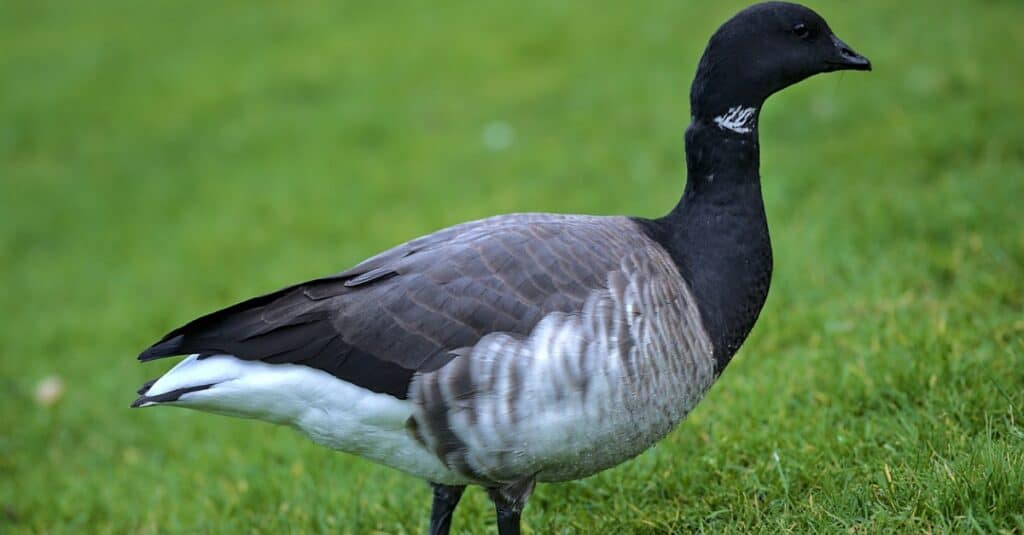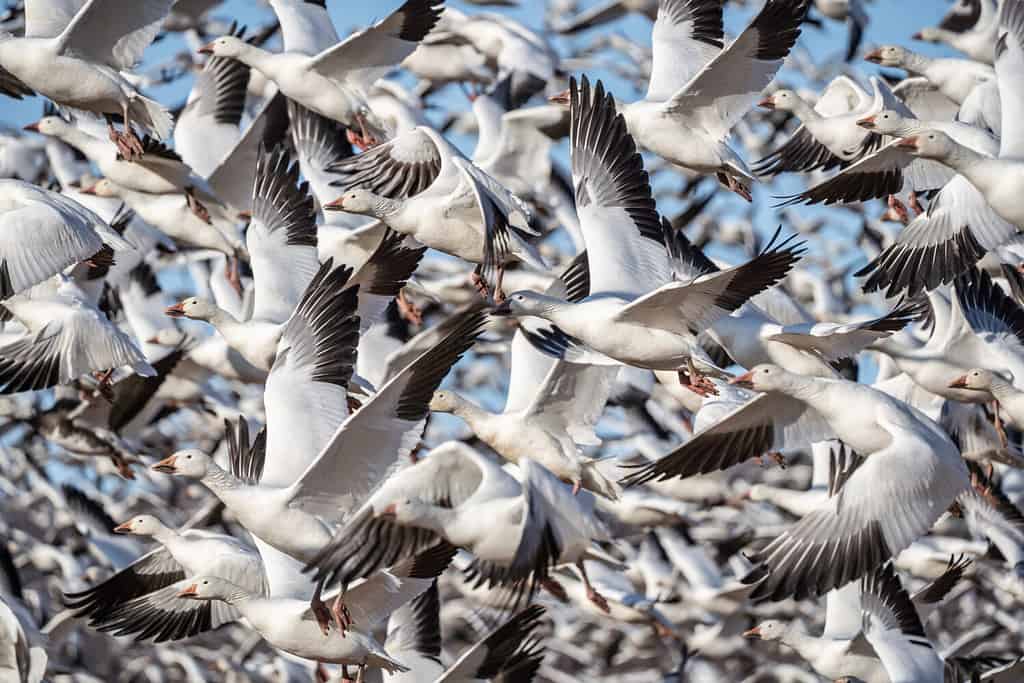Geese are iconic birds with V-shaped flight formations and distinctive honking calls. These birds are quite comfortable coexisting with humans and in human territory. But where exactly do geese nest, what materials do they use to build their nests, and what are their nesting habits overall?
Where Do Geese Nest?

Canada Geese are the most well-known species of geese. They are also the most widespread in North America.
©Erni/Shutterstock.com
These waterfowl are resourceful and adaptable, choosing a variety of environments to build their nests depending on the specific species of goose.
Geese are known for their migratory nature. If they breed in northern regions, they tend to travel greater distances between their breeding and wintering grounds. Whereas if they breed in southern regions, they tend to migrate shorter distances, if at all. That said, some populations of geese are residentiary. However, the majority tend to migrate to some degree. Consequently, the locations where geese nest can be quite diverse, ranging from Arctic tundras to wetlands, meadows, and even urban environments. The choice of nesting site often depends on the species of goose and their migration patterns.
Arctic Tundra Nesting Sites
Several species of geese, such as the Snow Goose and the Greater White-Fronted Goose, often choose their nesting grounds in the Arctic tundra. These vast, remote landscapes provide a haven from predators and ample access to their preferred diet of grasses and sedges.
Wetland and Marsh Nesting Sites
Canada Geese are known to be adaptable and can be found nesting in a wide range of habitats. Wetlands and marshes are particularly favored due to the availability of water for foraging and the protection they offer against predators. Canada Geese are also frequently seen nesting in urban areas. Moreover, the Greylag Goose chooses to nest close to water as well.
Meadow and Grassland Nesting Sites
Some geese, like the Brant or Brent Goose, favor grassier habitats for nesting. These habitats provide ample grazing opportunities, and the geese can use their keen eyesight to spot potential threats from a distance.
Urban Area Nesting Sites
Over the years, there has been a noticeable increase in geese nesting in urban environments. Canada Geese, in particular, have adapted to city parks, golf courses, and even rooftops, where they find suitable nesting sites and foraging opportunities.
Nesting Habits of Geese

Snow Geese are a well-known species. In the Pacific Northwest, the winter is in large numbers in Skagit Valley, Washington every year.
©Florence-Joseph McGinn/Shutterstock.com
Monogamous Bonds and Territorial Behavior
Geese develop strong monogamous bonds, often forming lifelong partnerships with a single mate. And if their mate dies, they tend to find a new mate within a matter of months. During the nesting season, these pairs work together closely to manage nesting responsibilities. Amongst many species of geese, the females select a suitable nesting site and build the nest, while the males defend the nest and family. Once hatched, both males and females tend to care for and protect their goslings.
Once a suitable nesting site is identified, geese become highly territorial and protective of their chosen spot. They vigorously defend their territory against intruding geese or other potential threats, often engaging in vocal displays and physical confrontations.
Egg Laying, Incubation, and Nest Maintenance
Female geese typically lay a clutch of eggs, with the number varying depending on the species. Canada Geese, for example, commonly lay between 2 to 8 eggs. The eggs are usually laid one and a half days apart, and incubation begins after the last egg is laid.
Incubation is a crucial phase in the nesting process. The female goose takes on the primary responsibility for incubating the eggs while the male stands guard nearby. Incubation periods can last around 20 to 28 days, during which time the female rarely leaves the nest and relies on her mate to provide her with food.
Geese are meticulous in maintaining their nests. They frequently add fresh plant material to the nest, ensuring it remains well-insulated and comfortable for the developing embryos.
Hatching and Gosling Care
Once the eggs hatch, the goslings are highly precocial, meaning they are born highly independent with their eyes open, they are covered in down feathers, and they can feed themselves. The parents are diligent in protecting and caring for their goslings. Goslings are guided to water soon after hatching, as water is a safer environment and provides access to their preferred diet of aquatic vegetation.
Family Cohesion and Migratory Behavior
Goslings remain with their parents for several weeks, on average up to 70 days, learning essential survival skills and gradually becoming more independent. During this time, the family forms a cohesive unit, often seen swimming together in ponds or foraging in meadows. Furthermore, larger populations of geese with many broods often form gang broods, where multiple individual broods feed together, travel together, and loaf together.
For many goose species, the nesting season is closely linked to their migratory patterns. After successfully raising their goslings, families of geese prepare for their long journey to wintering grounds, where they can find more abundant food sources.
Materials Geese Use to Build Nests
Their nest construction is a carefully orchestrated process that relies on locally available materials. Geese are naturally resourceful, and their nests are generally simple yet sturdy structures. Once again, the materials they predominantly use depend on the species of goose.
Geese predominantly use vegetation in their nest-building efforts. This includes grasses, sedges, reeds, and twigs. The female goose plucks these materials with her beak. She then arranges them into a shallow depression on the ground, forming the nest’s base. Many female geese use their down feathers to line the nest and provide insulation. These feathers are incredibly warm and help keep the eggs and, later, young goslings cozy.
In some cases, geese may utilize natural hollows or depressions in the ground as their nesting sites. These depressions may already contain some plant material, which the geese then rearrange and reinforce. Furthermore, geese may utilize stones or mud to structure their nests in areas where vegetation is scarce. This is a less common practice but demonstrates their adaptability.
It’s worth noting that while the basic structure of a goose nest remains consistent, there can be variations in the size and complexity of the nest depending on the subspecies and the environment. For instance, Arctic-nesting geese may build more substantial nests to combat the extreme cold. At the same time, those in milder climates may opt for simpler constructions.
Overall, geese are adaptable birds with a thorough approach to nesting. Their choice of nesting sites, ranging from Arctic tundras to urban landscapes, showcases their adaptability. Their resourceful use of vegetation, down feathers, and even twigs, reeds, or mud to build nests highlights their ability to thrive in diverse environments. Furthermore, they form strong family bonds and often revisit the same locations and migratory patterns.
Species and Characteristics of Geese

Geese are categorized into two genera, which include
Anserand
Branta. The Brent Goose is a part of the
Brantagenera.
©iStock.com/Roman Overko
Geese are a diverse group of birds found across the globe. They are considered waterfowl and are a part of the Anatidae family. Within this family are two genera, which include Anser and Branta. Let’s take a look at the characteristics of geese and popular species of geese.
How Many Species of Geese Are There?
The family Anatidae, which includes ducks and swans in addition to geese, comprises over 170 species across 43 genera. Among these, there are over 17 recognized species of geese. Geese reside worldwide and are distributed across various ecosystems, showcasing the adaptability and resilience that are hallmarks of this remarkable family of birds.
Characteristics of Geese
Geese have several distinctive characteristics that set them apart from other birds.
Size, Coloration, Neck Length, and Voice
According to All About Birds, geese vary in size, with one of the smallest species, the Brant Goose, measuring around 24 inches (61 centimeters) in length. In contrast, one of the largest, the Emperor Goose, can reach lengths of up to 28 inches (71 centimeters). Their wingspan ranges from 25 inches (64 centimeters) to an impressive 75 inches (190 centimeters).
Most geese display a combination of brown, gray, and white plumage. However, the exact coloration varies between species and is influenced by age, sex, and geographic location. For instance, the Canada Goose has a distinctive black neck, white cheek patches, white underbelly, and a predominantly brown body.
The length of a goose’s neck also varies. Some species, like the Greater White-Fronted Goose, have relatively short necks. In contrast, others, like the Canada Goose or Cackling Goose, have long, elegant necks.
Furthermore, geese are famous for their honking calls, which are used for comprehensive communication. Each species has unique vocalizations, ranging from melodious to raucous.
Migration, Social Behavior, and Diet
Many goose species are migratory, undertaking long or short-distance journeys between their breeding and wintering grounds. This migration shows their habitual journeys.
Geese are highly social birds and often reside in large flocks, especially during migration. They exhibit strong family bonds and often form monogamous pairs that raise their young together.
Furthermore, geese are primarily herbivorous, feeding on a diet of aquatic plants, grasses, grains, and berries. They are well-adapted to grazing and often reside in wetlands, meadows, and fields. However, they also eat a variety of invertebrates, insects, and even small mammals such as rodents.
Popular Species of Geese
While there are numerous species of geese around the world, a few stand out as particularly popular and well-known.
Perhaps one of the most iconic goose species, the Canada Goose, is recognized for its distinctive coloration pattern. They are highly adaptable and reside in a wide range of habitats, including urban areas.
Snow Geese have striking white plumage, and in the “blue” phase individuals have blue-gray plumage covering their bodies and necks. They undertake one of the longest migrations of any bird species, traveling from the Arctic down to as far as the southern United States in large flocks.
The Greylag Goose is the ancestor of many domesticated goose breeds. They are widespread in Europe and Asia and have a distinctive orange bill and pink legs.
The Barnacle Goose has a striking black and white plumage. They are often seen in northern Europe during their breeding season. Their name comes from a historical myth that claimed they hatched from barnacles.
The Greater White-Fronted Goose got its name from the white patch of feathers surrounding its bill. These geese have a wide distribution, ranging from North America to Asia. They are often residing in wetlands and around lakes and ponds.
Among the most distinctive of all geese, the Emperor Goose has a striking white face, dark gray body, and bright orange legs and feet. They primarily reside in coastal areas of Alaska. According to the IUCN Red List, this species is near threatened.
Geese are a diverse and captivating group of waterfowl with unique characteristics that vary between species. From their striking plumage to their honking calls, ritualistic habits, and impressive migratory journeys, geese continue to coexist with humans and thrive here on Earth.
Where and When Are You Most Likely to See Geese in North America?

The Emperor Goose is classified as “Near Threatened,” with decreasing populations by the IUCN Red List.
©iStock.com/Robert Thorley
North America is home to a diverse range of geese species, and observing these magnificent birds can be an easy adventure year-round, depending on where you are. The presence of geese varies across the continent, both in terms of species and the seasons in which you can encounter them.
Spring Migration: March through April
As the days grow longer and temperatures begin to rise, North America witnesses one of the most spectacular spring migrations of many bird species, including geese. During this time, you can observe large flocks of geese flying northward as they return to their breeding grounds. Some key locations to witness this awe-inspiring event include the following.
All four Flyways in North America, which include the Pacific Flyway, the Central Flyway, The Mississippi Flyway, and the Eastern Flyway, experience seasonal migrations of various species of geese. These flyways serve as a crucial corridor for the migration of geese, including the majestic Snow Geese and Canada Geese. Wetlands, agricultural lands, bodies of water, and coastal areas all provide critical resting spots for these travelers.
Breeding Season: May to August
As spring transitions into summer, geese settle into their breeding grounds across North America. Some key regions where you can encounter nesting geese include the following.
In the far north, species like the Snow Goose and the Ross’s Goose nest on the Arctic tundra. Observing these geese in their remote nesting grounds can often be in remote regions, but offers a unique glimpse into their family life.
The prairie potholes of the northern United States and Canada are prime breeding grounds for various goose species, including the Canada Goose. Lakes, ponds, and wetlands in states like Minnesota and provinces like Manitoba teem with nesting geese.
Fall Migration: September to November
The fall migration is another remarkable opportunity to witness geese in North America as they head south for the winter. The same flyways mentioned in the spring migration also apply to the fall migration. Once again, the various locations across bodies of water, agricultural lands, wetlands, and more provide important stopover points for these birds to feed and rest.
Wintering Season: December to March
As the cold grip of winter tightens its hold across North America, numerous goose species find refuge in milder regions further south or along the coasts, making this season an excellent time to observe them in these areas.
Southern states become important wintering grounds for a variety of goose species, including Snow Geese and White-Fronted Geese. Coastal wetlands, agricultural fields, and grasslands also provide essential feeding and resting areas for these migrating birds. For example, Skagit Valley in Washington state is a crucial wintering ground for various bird species, including the Snow Goose. You can view these birds wintering in the valley for approximately three to six months before they fly back to their breeding grounds.
The Central Valley of California also hosts significant numbers of wintering geese, including the Greater White-Fronted Goose and Ross’s Goose. Expansive agricultural fields and coastal areas create a haven for these birds. Furthermore, for some species, the journey continues south into Mexico. The warmer landscapes in these areas become important stopovers and wintering sites for geese like the Brant and the Cackling Goose.
Conservation Status of Geese Species

There are over 17 species of geese, most of which have a healthy conservation status.
©Amy Lutz/Shutterstock.com
Some species of geese are thriving and even overpopulated in some regions, while others are struggling to maintain healthy populations. Let’s take a look at ten species of geese and their conservation status.
Snow Goose
With its striking white plumage, the Snow Goose is categorized as “Least Concern” with increasing populations by the International Union for Conservation of Nature (IUCN). Populations of Snow Geese have seen significant increases in recent years, primarily due to protection measures and ample environments that provide abundant food throughout the year.
Ross’s Goose
Like the Snow Goose, the IUCN Red List lists the Ross’s Goose as “Least Concern.” You can often see these geese alongside Snow Geese during migration and winter. Their populations remain relatively stable, with no significant threats at present. The Migratory Bird Treaty Act also protects them.
Emperor Goose
The Emperor Goose faces a more precarious situation, classified as “Near Threatened,” with decreasing populations by the IUCN Red List. This species primarily resides in Alaska, and its numbers have declined due to habitat degradation, hunting, and climate change impacts on its Arctic breeding grounds.
Greylag Goose
The Greylag Goose, ancestral to many domesticated goose breeds, is currently classified as “Least Concern” with increasing populations. Although there may be specific populations experiencing declines due to habitat loss, overall populations remain stable and growing, aided by adaptability to various environments.
Greater White-Fronted Goose
The Greater White-Fronted Goose is classified as “Least Concern” by the IUCN Red List. However, its populations are not well documented and understood. Experts speculate that this species may be “Vulnerable” due to its limited range and small numbers. It faces threats such as habitat degradation, pollution, invasive species, and hunting. Overall, its population may be declining.
Tundra Bean Goose
The Tundra Bean Goose is classified as “Least Concern.” Although habitat loss and hunting can impact local populations, it has a wide distribution across northern Eurasia, helping maintain overall stability.
Barnacle Goose
The Barnacle Goose is classified as “Least Concern” with increasing populations. This species has experienced population increases and range expansions in recent years, attributed to habitat protection and conservation efforts in its breeding and wintering areas.
Canada Goose
The Canada Goose is classified as “Least Concern” with consistent and wildly increasing populations with each passing year. This adaptable species has benefited from urban habitats, leading to stable or increasing populations throughout North America.
Cackling Goose
Similar to the Canada Goose, the Cackling Goose is also classified as “Least Concern” with increasing populations.
Brant Goose
Lastly, the Brant Goose is classified as “Least Concern.” Conservation efforts have focused on protecting its coastal habitats, contributing to stable or increasing populations along the Atlantic and Pacific coasts.
The photo featured at the top of this post is © robert brown/iStock via Getty Images
Thank you for reading! Have some feedback for us? Contact the AZ Animals editorial team.







